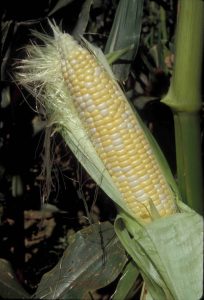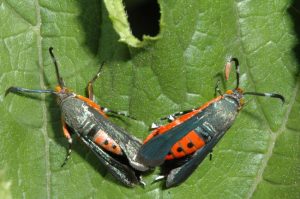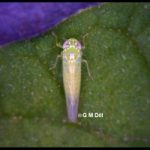Sweet Corn IPM Newsletter No. 3 – July 13, 2018
 Sweet Corn IPM Newsletter No. 3 – July 13, 2018
Sweet Corn IPM Newsletter No. 3 – July 13, 2018
Click on photos to enlarge.
LOW INSECT ACTIVITY IN CORNFIELDS
Few Moths or Damage Found This Week
SITUATION
Warm, dry weather continues to move corn development rapidly throughout the state, and many early fields are or will be silking within the next few days. Adequate irrigation is key to good ear fill during the silking stage if rainfall has been lacking. Drought stressed corn will often have very poor ear size and fill. Insect activity in cornfields was very low this week, perhaps related to cooler nighttime temperatures.
European corn borer: Very few moths were caught in pheromone traps this week, and only along the southern coast. Larval feeding damage was also below threshold in all fields scouted, as sprays applied over the past week have cleaned up fields that were recently over threshold. Some early fields are now silking, and when corn reaches that stage, sprays can be based on the number of corn borer moths caught in pheromone traps rather than feeding injury. However, none of our sites exceeded the 5 moth per week spray threshold.
Corn earworm: A single moth was caught in a pheromone trap in Lewiston this week. A spray was not recommended, even when some silking corn was present. Once more than one moth per week is captured in a silking field, a spray interval will be recommended, based on the number of moths being caught. There is still not much silking corn available for earworm moths to lay eggs on, so the threat remains low. Warmer evening temperatures and any weather fronts moving into Maine from the south could change the situation rapidly; although, as of this week, low earworm activity is also being reported from states to our south.

Fall armyworm: No moths were caught in our pheromone traps this week, and we have not yet found any feeding damage in the cornfields we’ve scouted. As with corn earworm, however, this situation could change rapidly if weather fronts from the south move into the state.
Squash vine borer moths were caught in pheromone traps in Biddeford, Lewiston and Oxford this week. Counts were below the spray threshold, but indicate that this pest will threaten squash and pumpkins this season. Moth counts in New Hampshire are over threshold this week, so activity here will rise soon. Squash vine borer moths are black and orange and resemble wasps. They lay their eggs at the base of squash plants. The larvae bore into the base of the plants, causing vines to wilt and collapse. Growers with squash in southern Maine should be on the lookout for vine borer symptoms and protect squash plants if moths or damage are seen. See the 2018-2019 New England Vegetable Management Guide for control options.

Potato leafhopper alert: potato leafhopper is now active in vegetable and strawberry fields. These small, bullet-shaped insects feed on plant sap from the undersides of leaves, causing the leaves to become curled, stunted and yellow-streaked. Beans are often the first crop to show symptoms, but other crops are also susceptible, including potatoes and strawberries. To scout for leafhoppers, brush the leaves of the plants with your hand. The small, whitish adults can be seen flying off the plant. Look for small, light green leafhopper nymphs on the underside of injured leaves. They are about 1/16-inch long. When touched, they will crawl sideways in a crab-like manner. Control options for potato leafhoppers are listed in the New England Vegetable Management Guide.
Maine State Pomological Society Summer Tour
The event will be held on Wednesday July 18, 2018 at Dole’s Orchard, 187 Doles Ridge Road, Limington, Maine 04048. Earl and Nancy Bunting will be hosting the Maine State Pomological Society Summer Tour at their farm this summer. Much of the focus will be on the tree fruit grown at Dole’s Orchard, including apples and cherries; but there are also large plantings of pic-your-own strawberries, raspberries and blueberries. Some of the fruit is also contracted to a local brewery. There will be a morning educational program, including talks from research and Extension Specialists, followed by lunch and afternoon tours of the fields and orchards led by Earl and Nancy. Plan to come visit this beautiful farm with us! Pre-registration is requested so we know how many lunches to request. Please contact Pam St. Peter at 207.933.2100 or pamela.stpeter@maine.edu for more information.

Two pesticide applicator credits will be offered for attending the summer tour’s full day program. Registration is $15 for Maine State Pomological Society members, and $20 for nonmembers. Registration payments by cash or check will be collected at the event.
Sincerely,
David T. Handley
Vegetable and Small Fruit Specialist
Highmoor Farm, P.O. Box 179, 52 US Route 202, Monmouth, ME 04259, 207.933.2100
UMaine Extension Diagnostic Research Lab, Pest Management Unit, 17 Godfrey Drive, Orono, ME 04473, 1.800.287.0279
| Location | CEW Moths |
ECB Moths |
FAW Moths |
%Feeding Damage |
Recommendations / Comments |
|---|---|---|---|---|---|
| Biddeford | 0 | 1 | 0 | 0% | No spray recommended |
| Cape Elizabeth I | 0 | 3 | 0 | 0% | No spray recommended |
| Cape Elizabeth II | 0 | 0 | 0 | 4% | No spray recommended |
| Dayton I | 0 | 0 | 0 | 6% | No spray recommended |
| Farmington | 0 | 0 | 0 | 13% | No spray recommended |
| Lewiston I | 0 | 0 | 0 | 0% | No spray recommended |
| Lewiston II | 1 | 0 | 0 | 0% | No spray recommended (no silking corn) |
| New Gloucester | 0 | 0 | 0 | 0% | No spray recommended |
| Nobleboro | 0 | 0 | 0 | 0% | No spray recommended |
| No. Berwick | 0 | 0 | 0 | 1% | No spray recommended |
| Oxford | 0 | 0 | 0 | 12% | No spray recommended |
| Wales | 0 | 0 | 0 | 0% | No spray recommended |
| Wayne | 0 | 0% | No spray recommended | ||
| Wells I | 0 | 0 | 0 | 4% | No spray recommended |
| Wells II | 0 | 0 | 0 | 0% | No spray recommended |
CEW: Corn earworm (Only fresh silking corn should be sprayed for this insect.)
ECB: European corn borer
FAW: Fall armyworm
| Moths caught per week | Moths caught per night | Spray interval |
|---|---|---|
| 0.0 to 1.4 | 0.0 to 0.2 | No spray |
| 1.5 to 3.5 | 0.3 to 0.5 | Spray every 6 days |
| 3.6 to 7.0 | 0.6 to 1.0 | Spray every 5 days |
| 7.1 to 91 | 1.1 to 13.0 | Spray every 4 days |
| More than 91 | More than 13 | Spray every 3 days |
Thresholds apply only to corn with exposed fresh silk. Lengthen spray intervals by one day if maximum daily temperature is less than 80°F.
European Corn Borer Thresholds
Whorl stage: 30% or more of plants scouted show injury.
Pre-tassel-silk: 15% or more of plants scouted show injury.
Silk: 5 or more moths caught in pheromone traps in one week.
IPM Web Pages:
UMaine Cooperative Extension Integrated Pest Management
Penn State Pest Watch for Sweet Corn
UMass Amherst Integrated Pest Management
Where brand names or company names are used, it is for the reader’s information. No endorsement is implied nor is any discrimination intended against other products with similar ingredients. Always consult product labels for rates, application instructions and safety precautions. Users of these products assume all associated risks.
The University of Maine is an equal opportunity/affirmative action institution.
